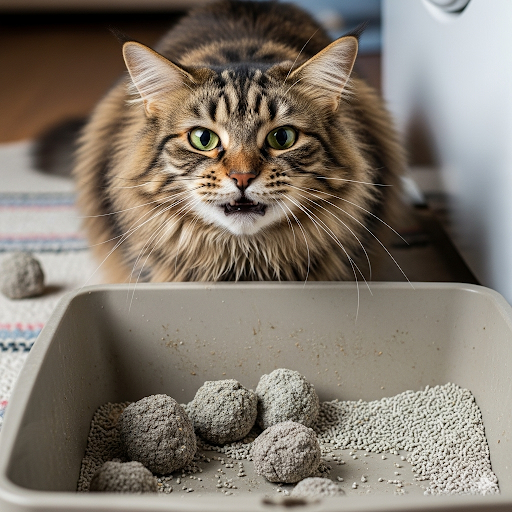If you're a cat parent, you're probably already keeping an eye on the litter box—but have you ever wondered if worms could be lurking in there? The short answer: yes, they can. Worms or their eggs can end up in the litter box if your cat is infected, and they can stick around long enough to pose a risk to other pets—or even you. Let's talk about how this happens, what to look for, and how to keep your home (and your cats) worm-free.
How Worms Get into the Litter Box
When a cat has worms, they usually pass eggs or segments of the parasites in their poop. That waste ends up in the litter box, along with tiny (often invisible) eggs or larvae. Some types of worms, like roundworms and hookworms, can survive in contaminated litter for a short time—especially if the box isn’t cleaned frequently.
If you have multiple cats using the same box, one infected cat can easily spread parasites to the others. Even if your cat is the only one in the house, there’s still a risk for re-infection if the litter box isn’t cleaned properly and regularly.
Can Humans Get Worms from the Litter Box?
While it’s not super common, it's possible—especially if you handle soiled litter and then forget to wash your hands. Roundworms and hookworms are zoonotic, which means they can be passed from animals to people. Kids, pregnant women, and people with weakened immune systems are more at risk.
Signs There Might Be Worms in the Litter Box
Keep an eye out for these clues:
-
Worms or rice-like segments in or around your cat’s poop
-
Poop that looks slimy or contains mucus
-
A foul or unusual smell
-
Frequent or loose stools
If you notice any of these, it’s time for a vet visit and probably a round of deworming.
Manual vs. Automatic Litter Boxes: Which Is Better for Detecting and Preventing Worms?
While automatic litter boxes are super convenient (especially if you hate scooping), they’re not always the best option when it comes to monitoring your cat’s health—especially for detecting worms.
🧤 Why Manual Litter Boxes Have the Upper Hand
Manual (standard) litter boxes may be low-tech, but they give you one major advantage: you see everything. When you scoop the litter yourself every day, you’re more likely to notice early signs of a worm problem, like:
-
Visible worms or segments (tapeworms often look like rice grains)
-
Unusual stool (loose, slimy, or discolored)
-
Changes in frequency or amount of poop
With automatic litter boxes, waste is usually swept away quickly into a hidden compartment—out of sight and out of mind. That might sound great, but it also means you could miss early warning signs of parasites.
How to Keep Your Litter Box Worm-Free
Here are some practical tips:
-
Scoop daily – This removes contaminated waste quickly before eggs have time to spread.
-
Change litter regularly – Don’t just top it up—dump it out and start fresh, especially if you suspect worms.
-
Wash the box with hot water and mild soap every week, or more often if there’s been a known infection.
-
Wear gloves when cleaning, and always wash your hands thoroughly afterward.
-
Keep up with regular deworming and flea control, since fleas can transmit tapeworms.
🛠 Tips for Keeping an Automatic Litter Box Worm-Free
If you love your automatic litter box (no judgment—it’s a game-changer!), you can still make it work safely by adding a few hygiene steps to your routine:
1. Inspect the Waste Tray Daily
Even if the litter box self-cleans, take a quick look inside the waste drawer. You might spot worm segments or strange poop that tells you something’s off.
2. Empty and Clean the Entire Box Weekly
Wipe down the sensors, rake, and waste drawer with hot, soapy water (or a pet-safe disinfectant). Parasite eggs can stick to surfaces, especially if moisture is involved.
3. Use High-Quality, Clumping Litter
Good litter traps waste effectively and makes it easier for the auto box to scoop it properly. This helps reduce the spread of parasite eggs in the remaining litter.
4. Don’t Skip Regular Deworming
Just because you’re not seeing anything doesn’t mean worms aren’t present. Stick to a vet-recommended deworming schedule, especially for outdoor cats or multi-pet households.
5. Have a Backup Manual Box During Treatment
If your cat is being treated for worms, it’s actually a good idea to temporarily switch to a manual litter box. That way, you can monitor the poop closely for signs of improvement—or ongoing infection.
Final Thoughts
While automatic litter boxes are great for convenience, they’re not a replacement for regular health checks—and your cat’s poop is one of the best indicators of their health. If worms are a concern (or if you're in the middle of treatment), a manual box gives you more control and insight. But if you prefer your auto-cleaner, just stay proactive with cleaning, inspections, and vet care, and you’ll be just fine.



